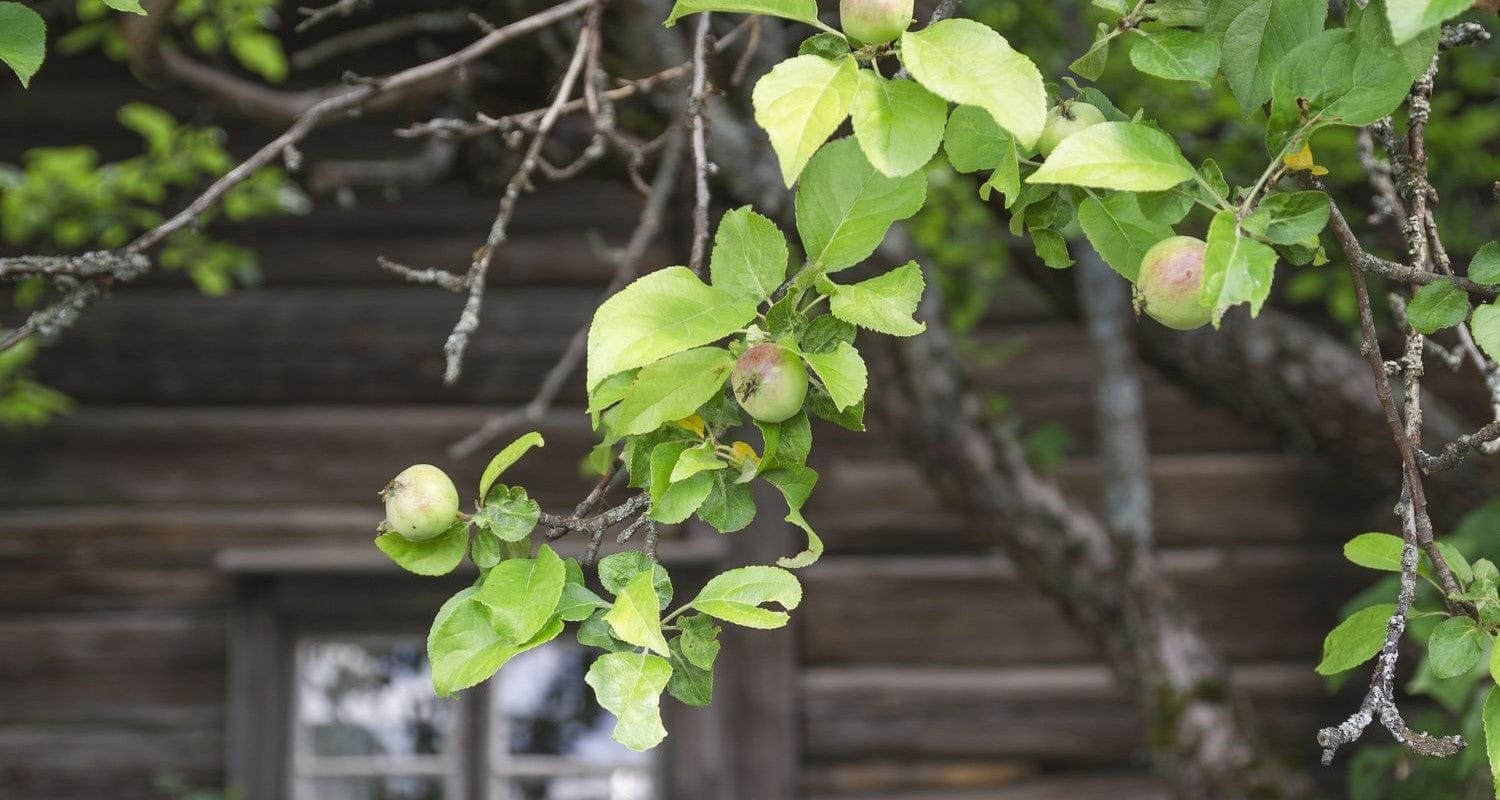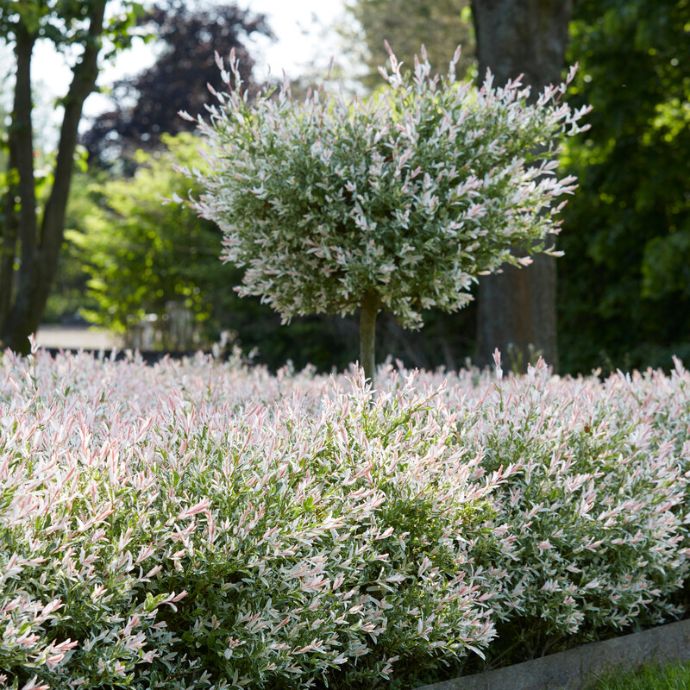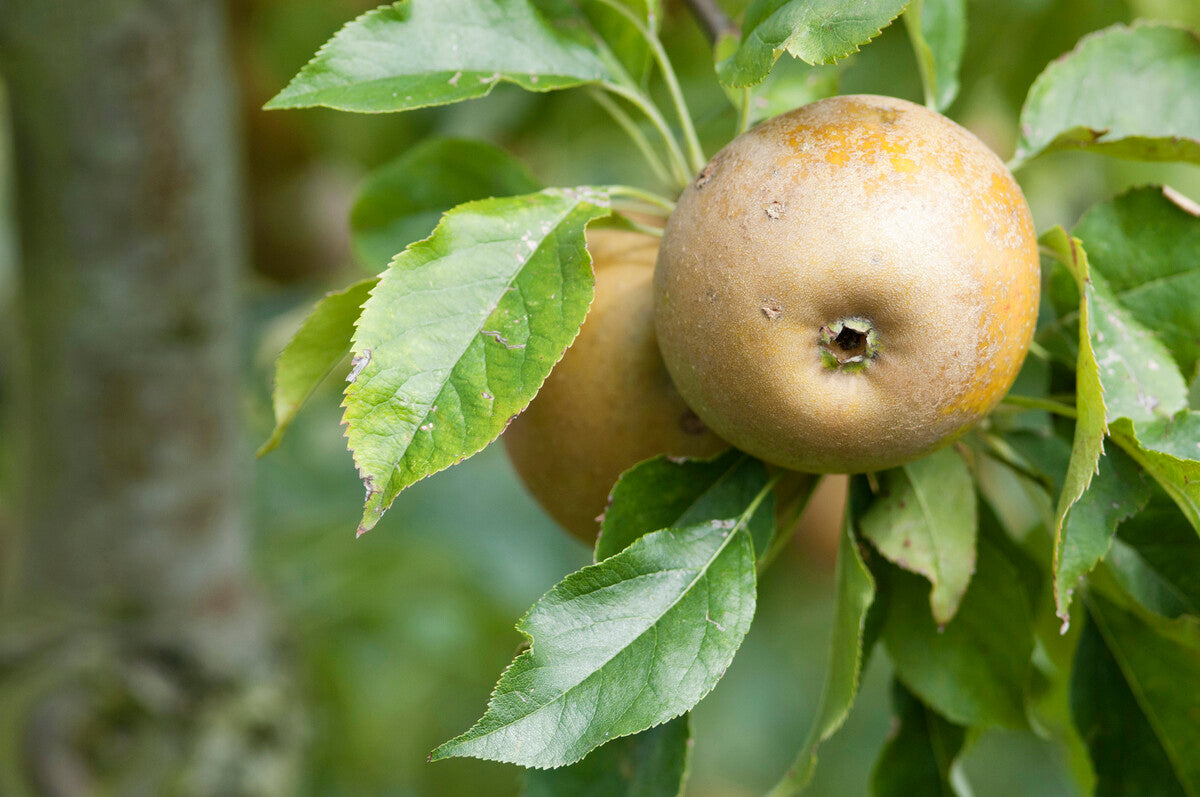Advice & Inspiration
Rare Apple Varieties: UK’s Best Heritage Apples

Over 2,000 varieties of apples grow in the UK, but just two varieties - Gala and Braeburn - make up half of all the apples we buy. These two are actually pretty tasty, but if you’re ‘lucky’ you might also find the misnamed Red Delicious or the ghastly Pink Lady®. Yep, it’s the first apple to be trademarked - that’s its claim to fame. This market dominance is so frustrating when you consider the vast choice of apple flavours we’re missing out on by accepting a narrow monopoly (monappley?) as the norm. Thankfully, adventurous apple fans have rebelled in recent years, seeking out weird, wonderful and just plain forgotten apples at specialist markets or by growing their own. So much so that there’s a bit of a boom in rare apple varieties going on! Fancy growing yourself a delicious rarity? Read on…
Jump to:
- What are heritage apples?
- Why are they endangered?
- Why are they important?
- UK’s rarest apples
- Where to try rare apples
- Can you grow rare apples?
- Best heritage varieties to grow
What is a heritage apple?
‘Heritage’ (sometimes called traditional or ‘heirloom’) simply means an old fashioned, often regional apple that isn’t commercially produced and sold. It’s quite a loose definition that usually means a variety dating back before 1950, but many of these apples are centuries older. As the name implies, they’re part of our social and cultural heritage, often preserving the names of places and people or dialect words that might otherwise have been lost to us.
Why are old apple varieties endangered?
Since the industrial revolution, there’s been a gradual severing of our connection to the land which still continues. We work long hours and don’t have time to grow our own food. We have to live in towns and cities near to where the work is, in smaller and smaller homes without the space to grow.
The rise of supermarkets dealt another blow to fruit diversity, as under this retail model, produce had to be the same shape, size and colour, being able to withstand being transported across a national delivery network (or flown across the world) and stored for months before being sold.
That’s the reason we ended up with big shiny apples like Red Delicious which have shelf appeal and the ability to survive fourteen months in cold storage, but taste like weak tea with a sweetener. Apples like these crop heavily and have few issues with pests (nothing can get through the tough skin) but lack the rich, complex flavours of something less showy like an Egremont Russet. As a consequence, the rich diversity of apples in the UK started to take a hit. The most endangered were the apples that don’t keep well, those that don’t crop on an industrial scale and those that are, well, a bit ugly.
Why are heritage apples important?
Homogeneity in pomiculture (fruit tree growing) is not just bad for our diets, but for the environment too. Different insect, bird and mammal species were happily evolving alongside specific tree varieties for thousands of years until Industrial Apples® came along, then suddenly they can’t even bite through the skins. #maggotproblems. Cross breeding amongst as many different trees as possible is also important for the survival of fruit species. Just look at the decline of the Habsburg dynasty for an example of what an overly narrow gene pool can do - it’s the same for fruit, only with fewer Holy Roman Emperors.
Heritage fruit also gives us a physical connection to our past, when we enjoy the same apples (sometimes from the same tree) that our great grandparents and generations further back would have enjoyed. The names of orchards long since lost, events, people and even scientific discoveries are all commemorated in the names of heritage apples, as well as words that were once common. Did you know ‘pippin’ just means an apple grown from seed?
No one wants to live in some kind of dystopia where all the apples are glossy, tasteless and exactly the same size, but if we want to save the old varieties, we have to support the growers and sellers of heritage apples. Better still, we can grow our own and preserve them for future generations.

The UK’s rarest apples
Apples that look like mutant potatoes? Fruit from the 1500s? Bring it on. These historic apples are some of the rarest varieties still going, and you can even grow some of them!
Court Pendu Plat
This apple originates from France, with the name referring to the short stalk and flat shape of the fruit. It’s first recorded in the UK in 1613 but is said to have been cultivated by the Romans way back when. This is a very useful apple to have around, since it flowers late and avoids the risk of frost damaging the blossom. It’s a greenish-yellow apple with a red flush, which sometimes has a russet texture to the skin. The shape is very like a Cox apple, so it’s thought that Court Pendu Plat could be one of its ancestors.
The apples are ready to harvest in October, and are described as having a texture similar to cheese but thankfully not the flavour too! Used for both eating fresh and cooking, the flesh is quite dry and the intense flavour mellows with age.
Knobby Russet
One of the top contenders for the title of UK’s ugliest apple, West Sussex variety Knobby Russet is described as looking like a potato, but frankly that’s an insult to potatoes. The skin of the Knobby (or Knobbed) Russet is rough, green-brown in colour and covered in bumps and welts. It does however have a very good flavour - strong and earthy with a sweet aftertaste. This late autumn harvesting apple with its tough skin is unsurprisingly good to store for many months.
Decio
The Decio apple is one of the oldest named varieties on record, believed to have originated in the Roman Empire and spread throughout Europe during their campaigns. They’re first mentioned by the historian Francesco Bo in the 1520s, who writes that General Ezio brought the apples with him when fighting Atilla the Hun and also that they were a favourite of the Duke of Ferrara in the late 1520s. Decio is considered an endangered apple in the UK as there are very few trees left here, producing only a few apples each year. In other parts of the world with a more favourable climate, however, they appear to be doing much better.
Api Etoile
This distinctive looking apple is also known as the Star Apple, and has five distinct knobs which give it the shape of a chubby star. Its earliest mention comes in the seventeenth century by Swiss botanist Johann Bauhin in his book Historia Plantarum Universalis, where he calls it the Pentagonal Apple. This is a pretty rare apple, only grown in a few speciality orchards, which is a bit of a shame as it’s said to have an excellent aromatic flavour and great keeping qualities due to its naturally waxy skin.
Beverley Pippin
The Beverley Pippin is just one example of an apple that was widely grown in a particular part of the UK (in this case East Yorkshire) but nowhere else, and has now been pushed out by Big Pomiculture. There were once hundreds of these regional specialities up and down the UK, many of which are now being revived thanks to the increased interest in community orchards. You can see this one at the Millenium Orchard in Beverley, along with other old Northern varieties such as the Hornsea Herring, Fillingham Pippin, Cockpit, Hunthouse Pippin and Ribston Pippin.
Where to try rare apples
If you want to see (or better still bite into) rare apple varieties, the best place to go is to an apple day. The first National Apple Day was held by Common Ground in 1990, and since then it’s grown in popularity, with hundreds of events across the UK. Most of these are held on October 21st, but check here for the dates of upcoming apple days near you. Farmers markets (heck, any market really) and farm shops are places where you can sometimes find a good local apple haul - or why not pay a visit to your local community orchard?
Apple Wassailing
Love apples? And British history? Apple wassailing might be for you. (What do you mean, you’ve never gone out to the local orchard in January wearing a funny hat and left soggy toast at the bottom of a tree?) This ancient custom originates in the West Country and is carried out in orchards across the UK every year to encourage the trees to crop well. The rituals vary, but most involve singing, shouting, beating drums or otherwise making a noise, then leaving offerings by the trees and drinking plenty of cider. It would be rude not to.
Can I grow a rare apple variety?
The variety of heritage and rare apple trees available to grow has really boomed in recent years, as demand increases. With an awareness of smaller living spaces, tree breeders have also created many dwarf or patio versions of these, so even if you don’t have a garden, you can still enjoy heritage fruit from your own tree as well as helping to keep these lovely old varieties alive. They’re usually no harder to grow than more mainstream apples, and are widely available online, especially during bare root season (November to March) when you have a much wider choice.
Heritage apples to grow
An added bonus of growing heritage apples is discovering the interesting origin stories behind your trees. Superb taste and garden bragging rights with a side dish of history? Don’t mind if I do. These are some of our growers’ favourites.
Beauty of Bath
Beautiful to look at as well as taste, this apple is sweet, aromatic, soft and sweet, with a pale yellow skin flushed with pink or red. Introduced in 1864 by George Bradley of Bailbrook near Bath, it received one of the first RHS awards in 1887.
One of the earliest apples to ripen, Beauty of Bath is usually ready to harvest from August but has been known to crop as early as July, so to prevent the fruit being damaged by premature dropping, Beauty of Bath trees traditionally have straw laid around the base of them to cushion the apples’ fall.
Pitmaston Pineapple
The Pitmaston Pineapple has one of the most surprising flavours of any apple - the supermarkets would not approve. These apples are small (detract one mark), russeted (boo) and have a rich, nuanced taste with notes of honey, nuts and pineapple (what would the shareholders think?). The Pitmaston Pineapple was raised by a Mr White, the steward to a Lord (so many of these early apple breeders were) in the village of Witley, Surrey in around 1785. They’re ready to harvest in October and will keep until at least December.
Bloody Ploughman
This apple not only has the best colour (deep red skin and flesh) but the coolest origin story too. In the 1880s, it is said that a ploughman was caught stealing apples from some rich aristo’s estate in Scotland, and shot dead by the gamekeeper. When the ploughman’s body was returned to his widow, she found one of the apples in his pocket and flung it on the rubbish heap. The tree that sprang from the fateful apple’s seeds produced blood red fruit. Despite their morbid origins, Bloody Ploughman apples are delightful to eat, with a juicy and sweet flavour, ripening in September.
Egremont Russet
We don’t have the name of the gardener who bred this wonderful apple, unfortunately, but it originated at Petworth in Sussex, the home of the earls of Egremont. Dating back to at least 1872, Egremont Russet is a favourite with apple connoisseurs, who admire its mossy green-brown, rough textured skin and rich, nutty flavour. It’s also a great tree for growing in colder areas of the UK, as it’s very hardy and the flowers are frost resistant. Egremont Russets ripen in October and can be stored until Christmas - perfect for your cheese board!
Dabinett
You don’t often see the beautiful old cider apple varieties - not unless you live in Somerset, I guess. They’re coming back with a vengeance though, as more and more people rediscover the traditional practices of cider making and juice pressing. Dabinett is a high quality, reliably cropping example, with a strong, fruity, astringent flavour that makes a full bodied cider. It originates in the Martock-Kingsbury area of Somerset, and is harvested late in the season, around November.
Isaac Newton’s Tree
The original tree from which Isaac Newton’s revelatory apple supposedly fell died in 1814, but if you scout around, you can still find trees for sale which have been propagated from its descendants. The variety is a Flower of Kent apple, and seeds from the trees have been taken into space, then planted at scientific research facilities throughout the world. There’s also one which is a genetic clone of the original growing outside Trinity College, Cambridge, where Newton studied.
Despite its illustrious pedigree, the Isaac Newton tree produces ugly looking cooking apples, and not very many of them!
Blenheim Orange
This award winning apple was first discovered by a Mr Kempster at Woodstock near Blenheim, Oxfordshire, England in about 1740, although it seems he kept it to himself until 1818, when it was first sold. Can’t say I blame him honestly. Blenheim Orange is a versatile dual purpose apple, which you can pick in September to cook or in October to eat straight from the tree. They’re highly aromatic with a creamy flesh and a good flavour balance, with the sugars increasing the longer they stay on the tree.
Discover many more varieties of heritage apple trees and how to grow them.




















